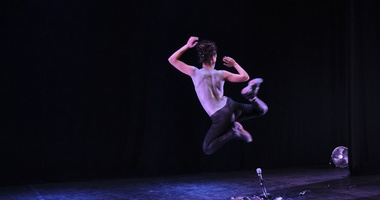Distante - Paisagens, Máquinas, Animais
Né Barros
Existem formas de combate que evoluíram para a dimensão de jogo, tal como a esgrima. Ao longo da peça Distante, terceira da série Paisagens, Máquinas e Animais, os bailarinos são jogadores, convocam a técnica como forma evoluída de nos relacionarmos no corpo a corpo. O corpo-máquina deverá, sobretudo, seguir esta linha, ser capaz de moldar o instinto e dar-lhe uma nova vida ética. A máquina, neste sentido, é a possibilidade de através da técnica e do tecnológico, expandir o corpo e o lugar sem o territorializar. Uma mensagem antiguerra se quisermos... Distante pela dimensão ética perante o outro, distante por um tempo pautado pela repetição, um tempo maquinal usado sobretudo para rememorar.
A motivação para fazer uma série de projetos em torno das paisagens, máquinas e animais, surge da necessidade de pensar uma peça que não se esgotasse num único espetáculo, mas que pudesse dialogar com outras obras. A recorrência da paisagem e do corpo como paisagem nos meus projetos, mesmo não sendo sempre de uma forma óbvia, determinou este ciclo de trabalho que se iniciou com IO, prosseguirá com Neve e terá a terceira parte com Distante. Esta aventura ficcional, deve resultar num diálogo inter-peças e intra-peça. Paisagens, Máquinas e Animais, os conceitos aqui envolvidos, evidenciam três pontos de fuga na definição do humano e, simultaneamente, abrem-se como categorias para pensar o corpo performático. Em todas as peças, estas dimensões estão presentes e se cruzem, embora, o ponto de partida para cada uma se situe, respetivamente, em cada uma das dimensões. Se em IO o corpo convoca o animal e o mitológico, o primitivo e o tecnológico, em Neve, emerge a paisagem nas suas variantes, ou seja, paisagem como o fora, o exterior, o indivíduo como paisagem inteligente, a paisagem emotiva e sonora, a imagem filmada como paisagem narrativa. Em Distante, partimos da ideia de um corpo-máquina que permita trabalhar nesse paradoxo do distante-próximo e que parte da técnica como ferramenta fundamental de humanização.
Né Barros
Coreógrafa e investigadora, ao longo da sua carreira tem desenvolvido em ligação os seus trabalhos artísticos com os científicos. É doutorada em Dança (FMH, UTL), Master of Arts in Dance Studies no Laban Centre (City University, Londres) e investigadora no Instituto de Filosofia no Grupo de Estética, Política e Conhecimento (UP), onde realizou um pós-doutoramento. Iniciou a sua formação em dança clássica e, mais tarde, trabalhou dança contemporânea e composição coreográfica nos Estados Unidos, no Smith College. Nos seus projetos tem colaborado com artistas de fotografia, música, artes plásticas e cinema. Além do Balleteatro, estrutura que dirige e fundou, trabalhou com a Companhia Nacional de Bailado, com o Ballet Gulbenkian e com a Aura Dance Company. Professora na Esap e convidada em diversas instituições. É autora de Performances e Pós-fenomenologia, Da Materialidade na Dança e editor de vários livros e tem publicados diversos artigos no âmbito da teoria e estética das artes performativas. Co-diretora das coleções Estética, Política e Artes e Máquinas de Guerra, da Faculdade de Letras do Porto. Co-dirige o festival internacional de cinema dedicado ao arquivo, memória e etnografia, Family Film Project.








